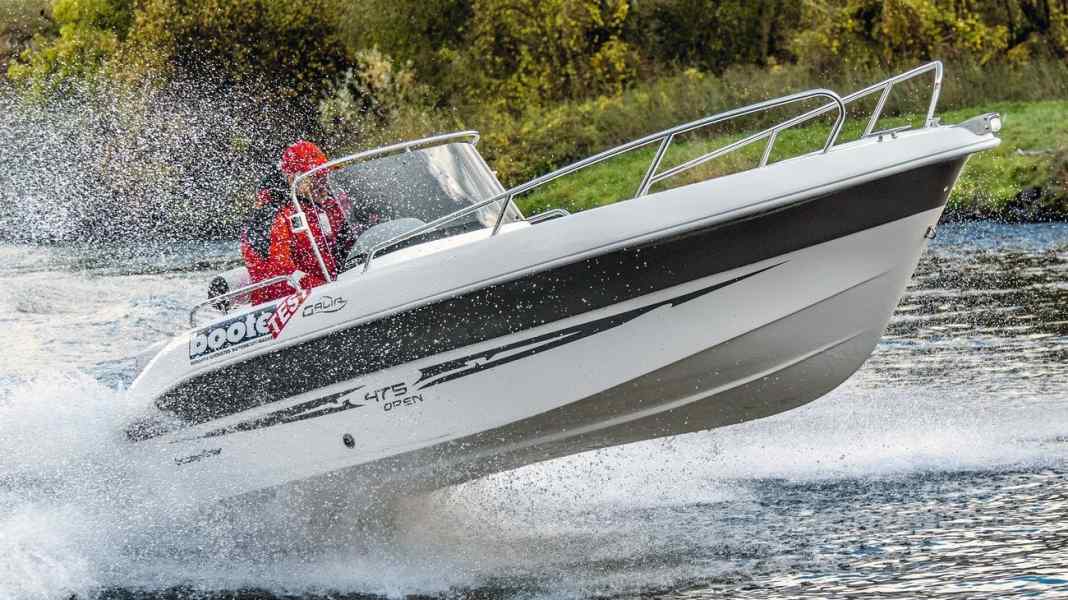
"Which boat should I buy to start with?" We have often heard this or a similar question from newcomers. In the past, the classic starter boat was usually an inflatable boat that could be dismantled. If it was supposed to fit in the boot of a mid-range car, the limit was around 3.50 m in length plus a 5 hp outboard motor (old driving licence limit).






If you already had a driving licence, you could of course upgrade the engine, but over 15 hp (new driving licence limit) it becomes quite heavy and it is best to use a trailer with which the boat and engine can be transported comfortably.
Then there are also family-friendly, i.e. larger inflatable boats or even a so-called RIB (inflatable boat with a solid hull, usually made of plastic), possibly even a completely solid boat - like our test Galia 475.
Without the engine it weighs around 500 kg, plus the test engine (around 110 kg) the total weight is around 610 kg. With an unbraked 750 kg trailer, you can no longer tow this with a clear conscience. The captain of the country road should play it safe and take a braked 1 t trailer, especially as he can then also leave the equipment on board.
The Galia is approved for four people, who have the appropriate amount of space on board. This includes the rear bench, where the driver also sits, a small bench in front of the driving position and the front bench.
If you then add the table (extra), you can have a cosy chat with snacks and cool drinks or relax and sunbathe with the table and cushions lowered. To cool down, you can then use the rear exit on theSplit bathing platform.
There is a sufficiently wide swim ladder for easy entry and exit. On the other side, there is a stowage box for lines. The Galia 475 has no shortage of storage options anyway, as there are storage compartments under all the seating options, plus the self-draining anchor locker (with roller) in the bow.
For theMovement safety on board teak floor (surcharge), railing and handrails. A grab rail runs around the windscreen (made of lightly tinted Plexiglas). The windscreen, which is curved at the ends, effectively protects the skipper from the wind. If the helmsman not only wants to know whether everything is in order with the engine, but also whether he is heading in the right direction, he pays extra for the compass, and the same applies to the horn.
Leaning all the way back, I have to make my arms really long to reach the steering wheel. The skipper has unrestricted access to the gearstick in all situations. If you push the gear lever slightly forwards, the engine engages smoothly and the Galia switches to a quiet displacement cruise, with the driver only having to make a few course corrections.
If you push the lever further forwards, the hull naturally rises and lowers again when the gliding speed is reached. The phase for our boat-motor combination is between 2500 and just under 4500 rpm. The bow only moves briefly into the field of vision, although two people are sitting aft - which is unfavourable for the trim.
If you then put the lever fully on the table, you can almost reach the maximum speed without power trim.
Pressing the trim button makes the hull run even more nimbly and increases the speed. However, we don't want to overdo it and stop trimming at around 6050 rpm and 22 knots. Here, a slightly larger propeller can help solo pilots with little equipment to achieve even more speed.
In fast bends and turns, the trim should be set to down so that the propeller catches air as late as possible. Once it has drawn air, briefly easing off the throttle will help it to regain power.Speaking of power: steering out of the roundabout requires noticeably more muscle work than steering in.
Slalom courses can be sailed safely and accurately with and without trim. Skipping sport boat waves is great fun, and the amount of water spray is kept to a minimum. It's clear that you can't exactly cover hyper-long distances with a standard 25-litre outboard tank, but almost 40 nm is perfectly acceptable for this type of boat.
During mooring manoeuvres, the Galia impresses with tight turning circles in all directions and direct reversing behaviour in reverse.
The four cleats and the plastic rubbing strake also receive a positive rating. Everything is solidly constructed and also expertly fastened, which also applies to the cables and hoses throughout the boat.
We only have one criticism of the electrics: the fuses under the driving position can only be accessed with tools, as you have to remove the footwell shell first, which is fastened with screws. The overall workmanship is impressive, with neatly sealed edges and well-stitched upholstery on the plus points list.
The boat is attached to three towing eyes on the trailer. Water skiers and tube riders attach themselves to a towing triangle - the so-called Hahnepot - and have to deal with a flat stern wave.

